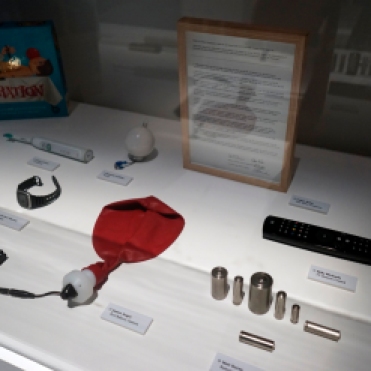
Cyborgs, superhumans and clones are alive amongst us today. What does it mean to be human now? What will it feel like to be a human a hundred years from now? Should we continue to embrace modifications to our minds, bodies and daily lives, or are there boundaries we shouldn’t overstep?
This exhibition presents a future world where the lines between fiction and reality are blurred and shows how our perception of humanity is being transformed by science and technology. Showcasing works by international artists, scientists, technologists and designers, the exhibition consist of 4 chapters; AUGMENTED ABILITIES, ENCOUNTERING OTHERS, AUTHORING ENVIRONMENTS and LIFE AT THE EDGES.
AUGMENTED ABILITIES

Avatar Machine

Prosthetic arm with attachments 1920-1940

Prosthetic arm


Law of Averages
ENCOUNTERING OTHERS

Area V5 is a wall of disembodied robotic eyes that follows visitors as they walk by. The title of the work refers to the visual area V5 in the brain cortex which is thought to play a major role in the perception of motion.
Misbehaving: Media Machine Act Out.
LIFE AT THE EDGES

Optimization of Parenting, Part 2 is a robot arm that gently rocks a bassinet whenever the baby inside cries or awakes from sleep. Can some automatic repetitive tasks be transferred to robotic devices without affecting the development of the baby?

Transfigurations, consists of sculptures representing five babies, each with a surgically implemented body modification.
I find this exhibit rather interesting. The Afterlife project is intended to instigate a metaphysical dialogue, examining the cultural shift from belief systems upheld by organised religion to the more factual basis of science and technology. The project proposes the harnessing of our chemical potential after biological death through the application of a microbial fuel cell, harvesting its electrical potential in a dry cell battery. The afterlife battery can be used to run a range of memorial products chosen to suit the needs of the individual.

Made in Singapore, Nadine is one of the most realistic female humanoid social robots in the world. Nadine was modelled after Professor Nadia Magnenat Thalman. The technology is being developed for people with special needs. She can be a companion who assists people who need extra support. She can also read stories, show images, begin Skype sessions, send emails, and communicate with the user’s family. You will have the chance to interact with Nadine from 2:00pm to 7:00pm daily.
HUMAN+ The future of our species
Now till 15 Oct 2017
ArtScience Museum, Singapore
Get your tickets here!
lonelytravelog.com




